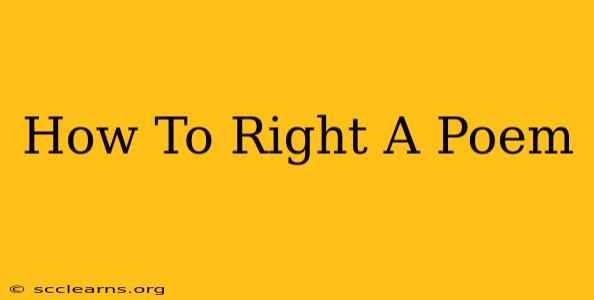So, you want to write a poem? That's fantastic! Poetry is a powerful form of expression, allowing you to explore emotions, ideas, and experiences in a unique and creative way. Whether you're a complete beginner or looking to refine your skills, this guide will help you on your poetic journey.
Finding Your Voice: The First Steps in Poetry
Before you even think about rhyme schemes or meter, the most important thing is to find your voice. What makes you unique? What experiences have shaped you? What stories do you want to tell? Your poem should reflect your personality and perspective.
1. Brainstorming and Inspiration:
- Freewriting: Set a timer for 10-15 minutes and just write. Don't worry about grammar, spelling, or even making sense. Let your thoughts flow freely onto the page. This is a great way to unlock hidden ideas.
- Sensory Details: Engage all five senses. What do you see, hear, smell, taste, and feel? Vivid sensory details bring your poems to life.
- Word Associations: Start with a single word and write down related words, images, and emotions. This can lead to unexpected and inspiring connections.
- Draw Inspiration from Life: Your experiences, observations, and emotions are rich sources of inspiration. Pay attention to the world around you.
Crafting Your Poem: Structure and Style
Once you have some ideas, it's time to start shaping them into a poem. There's no single "right" way to write a poem, but understanding some basic structures and techniques can be helpful.
2. Choosing a Form:
- Free Verse: This is a popular form that doesn't follow a set rhyme scheme or meter. It allows for greater freedom and flexibility.
- Sonnet: A 14-line poem with a specific rhyme scheme and meter (usually iambic pentameter).
- Haiku: A three-line poem with a 5-7-5 syllable structure.
- Limerick: A five-line poem with a specific rhyme scheme (AABBA).
- Acrostic: A poem where the first letter of each line spells out a word or phrase.
Experiment with different forms to find what suits your style and subject matter.
3. Mastering Poetic Devices:
- Metaphor: A comparison between two unlike things without using "like" or "as." (e.g., "The world is a stage.")
- Simile: A comparison between two unlike things using "like" or "as." (e.g., "He was as brave as a lion.")
- Imagery: Using vivid language to create pictures in the reader's mind.
- Personification: Giving human qualities to inanimate objects or animals.
- Alliteration: The repetition of consonant sounds at the beginning of words. (e.g., "Peter Piper picked a peck of pickled peppers.")
- Assonance: The repetition of vowel sounds within words. (e.g., "Go slow over the road.")
- Consonance: Repetition of consonant sounds within or at the end of words. (e.g., "All mammals named Sam are clammy.")
Refining Your Craft: Revision and Editing
Writing a poem is an iterative process. Don't expect perfection on the first draft. Revision is crucial to honing your craft.
4. Revising Your Poem:
- Read Aloud: Hearing your poem spoken aloud can help you identify awkward phrasing or clunky lines.
- Seek Feedback: Share your poem with trusted friends or writing group for constructive criticism.
- Cut Unnecessary Words: Poetry is about precision. Every word should serve a purpose.
- Refine Your Imagery: Make sure your images are clear, vivid, and evocative.
- Check for Consistency: Ensure your tone, style, and voice remain consistent throughout the poem.
Beyond the Basics: Continued Learning and Growth
Writing poetry is a lifelong journey. The more you write, the better you'll become. Consider these paths for continuous improvement:
- Read Widely: Read poems from different eras, styles, and poets. Pay attention to how they use language, structure, and imagery.
- Join a Writing Group: Get feedback from other writers and share your work in a supportive environment.
- Take a Poetry Workshop: Learn from experienced poets and receive personalized instruction.
- Experiment: Don't be afraid to break the rules and try new things.
By following these steps and continuously practicing your craft, you can unlock your potential as a poet and create powerful and moving works of art. So grab your pen (or keyboard!), and start writing!

